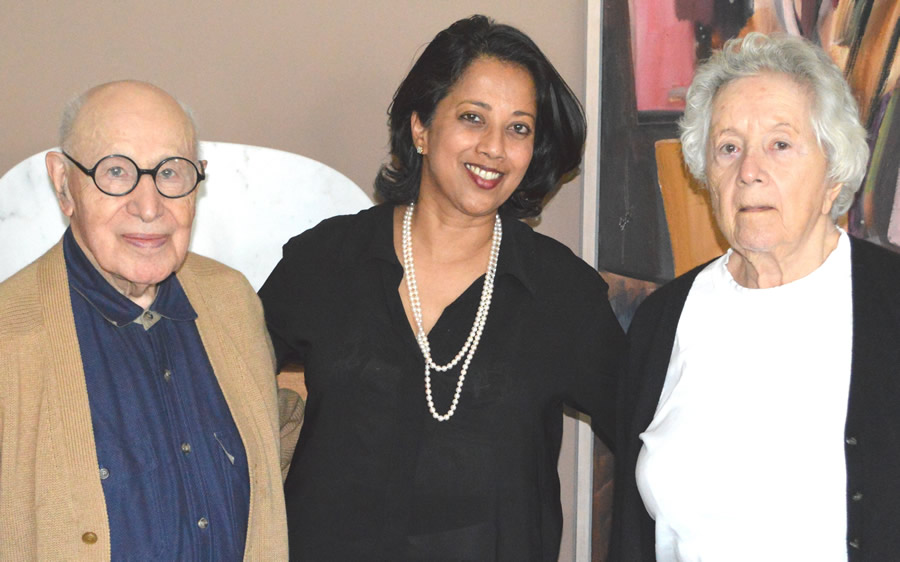LEIBER’S LEGACY OF INNOVATION, WORKMANSHIP AND CREATIVITY WILL BE REMEMBERED FOR YEARS TO COME
By Saini Kannan
Judith Leiber elevated the mundane and practical handbag to an important accessory, beginning in 1953 when she designed the bag Mamie Eisenhower took to the inaugural ball. With the introduction of her sparkly metal and crystal minaudières (the Chatelaine, 1967), Leiber freed women from the hassles of having to go to their vaults every time they needed to wear a minaudière. Her pieces were not just precious, but wearable, practical and witty. No designer was doing that back in the 1960s.
HANDBAGS
When Judith passed away earlier this year at her home in New York, The New York Times praised her imaginative and eye-catching designs, among them colorfully beaded bags in animal, flower, fruit and egg shapes, and bags shaped like boxes and shells with variations on antique Asian motifs. Her whimsical creations, the paper said, were prized as collectors’ pieces and frequently displayed as objets d’art.
Enlarge

Judith died just hours after the death of her husband of 72 years, the painter, lithographer and sculptor Gerson Leiber.
I first met Judith in 2012 after years of collecting her designs. Over the years, I have collected and curated many of the most important of the 3,500 handbags she designed in the 35 years after founding the Judith Leiber company. Her unique skin bags included the essence of the major art movements – Art Deco, Art Nouveau, Realism, Expressionism and Post Modernism. Her crystal minaudière designs included multicultural and global influences of China (the Foo Dog), Japan (the fluttering fan of a Geisha), India (Parsi Gara), Russia (Fabergé eggs) and numerous European designs that a woman could wear with confidence on the world stage. These women included first ladies (American and Russian), English royalty (Queen Elizabeth II), and Hollywood stars like Elizabeth Taylor and Greta Garbo. Judith distilled a spirit of exoticism with a bold new feminism. She also laid the foundation and set the standards for what a woman’s handbag should be for generations to come. She set standards for the quality of workmanship (the highest) and the materials used (only the best of the best). She introduced a culture of innovation and creativity (combining gemstones with skins and crystal novelties), utilized rarely used colors (fierce Siam, soft Champagne, intriguing Ceylon) and, perhaps most importantly, created shapes and patterns that are relevant today, more than 50 years after her first design, and in an industry where last season is considered passé.
We could always count on Judith to bring wit and humor to women’s accessories. A woman can now wear her patriotism on her arm (with her oh-so-rare American Flag bag) at a cocktail party or on the red carpet.
Judith, in fact, created thousands of unique designs, and along the way created a genre that never existed before. Her repertoire of patterns, designs, shapes and cultures is a vast resource that will be exploited for years to come, not just by her successors, but by other designers as well. In my opinion, we have only seen the tip of the iceberg when it comes to Judith’s genius. Her influence will live on.
Enlarge

As I look back on our friendship, I can say we were drawn to each other from the first time we met. Together, we shared a unique vision and energy, and a philosophy of appreciating things and events.
As a woman, she epitomized our best traits. As a designer, she was among the most creative and innovative. She broke the glass ceiling and paved her way in a field that for decades was men only. Judith and her husband and partner in crime Gerson epitomized the Indian philosophical concept of universal love. They did not let any hurdle or challenge stop them on their journey together. Their love for each other, their love of art, their love of contributing to the world will always bring a smile to my face.
Always.
SAINI KANNAN is one of the world’s most prominent collectors of Judith Leiber handbags. She was featured in “Following the Leibers” in our Spring/Summer 2018 edition. This story appears in the Fall 2018 edition of The Intelligent Collector magazine. Click here to subscribe to the print edition.

